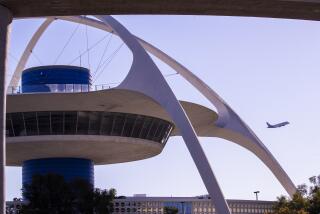FAA to Get Tough on Private Pilots in LAX Air Space
- Share via
The Federal Aviation Administration, reacting to the recent midair disaster over Cerritos, will put additional emphasis on identifying, catching and disciplining private pilots who violate the heavily regulated air space around Los Angeles International Airport, an FAA official said Thursday.
“We’ll even consider making their names public,” warned Jack Norris, accident prevention coordinator for the FAA’s four-state Western Pacific Region.
However, Norris refused to be specific about whether the increased vigilance will be accomplished primarily by hiring more air traffic controllers or relying on the existing work force, which according to some controllers and pilots is already overtaxed.
Norris, speaking to a safety seminar of several hundred pilots in Van Nuys, said air traffic controllers in the Los Angeles area will be given additional training on how to concentrate not only on controlling traffic but on looking for planes that violate Los Angeles International’s terminal control area or TCA.
The Los Angeles TCA is a huge area--52 miles long and 24 miles wide--and is separated into 12 zones. Each zone has its own specific lower and upper altitude limits.
A pilot may not enter any part of the TCA unless he first receives permission from air traffic controllers.
He must limit his speed to no more than 230 m.p.h., have on board his aircraft a two-way radio so that controllers can stay in contact with him and must have a transponder and an encoding altimeter. Together, these devices enable controllers to more accurately keep track of the aircraft’s route on their radar screens.
In the Aug. 31 crash over Cerritos, which killed as many as 81 people, a small Piper aircraft flew without authorization into the Los Angeles TCA and collided with a Aeromexico DC-9 making a routine approach.
FAA officials have said that small aircraft violate the Los Angeles TCA at least once a day. About half the time, the officials said, ground controllers must reroute other aircraft to avoid collision with the violators.
The FAA’s Norris also said FAA staff members, such as operational inspectors and air worthiness inspectors, will spend more time visiting general aviation airports to “counsel” pilots.
In addition, Norris said, FAA regional officials this week established a task force to review many facets of flight in Los Angeles that have been called into question since the Cerritos collision.
Jim Holweger, an FAA assistant operations manager, said earlier this week that the local review will examine whether the Los Angeles TCA is “too complex and difficult for pilots to understand” and how well the FAA “keeps pilots informed of their responsibilities in flying through or around the TCA.”
Pilots have traditionally complained that because the TCA was designed for the convenience of air traffic controllers, its boundaries are difficult to follow from the air.
Other issues to be studied by the task force include the complexity of the airport radar service areas that the FAA established at airports in Burbank, Long Beach, Ontario and Orange County in January to separate private and commercial traffic; pilot training; controller education, and aeronautical charts.
Norris’ lack of specificity frustrated some of the pilots in the audience Thursday night. One of them, wondering if the FAA plans to require all planes to be equipped with encoding altimeters, which allow a plane’s altitude to be transmitted to air traffic controllers, asked: “If you don’t require encoders, how can you catch these violators? Are you going to send a chase plane?”
Answered Norris: “That could very well be one of our recommendations.”
Most small planes in the Los Angeles area have transponders, but only about half have encoding altimeters. To a controller, a plane with a transponder but no encoding altimeter will show up on the screen as a plane flying at an indeterminate altitude.
The Cerritos collision raised the issue of whether all planes--not merely those that wish to fly through the TCA--should be required to have encoding altimeters.
The concern was so high that earlier this week the Los Angeles County Board of Supervisors asked the FAA to require all planes in the basin to have the altimeters and to require that the altimeters be wired to a plane’s ignition, so that pilots could not turn them off while flying.
The Aircraft Owners and Pilots Assn., which represents the nation’s small-plane owners and has lobbied against numerous proposals to restrict air space, opposes the basinwide altimeter requirement. A spokesman said that if all planes were flying with encoding altimeters, they would send enough data to overwhelm the aircraft control system.
More to Read
Inside the business of entertainment
The Wide Shot brings you news, analysis and insights on everything from streaming wars to production — and what it all means for the future.
You may occasionally receive promotional content from the Los Angeles Times.










